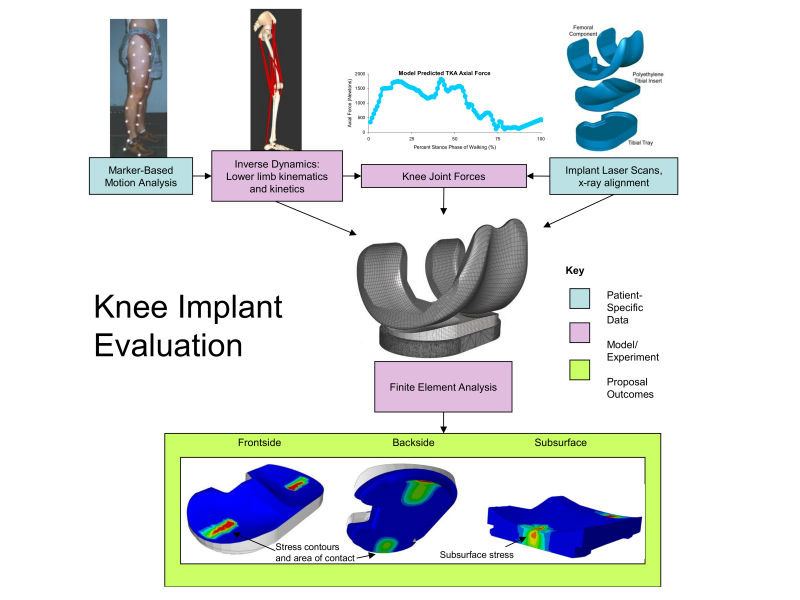The Computational Biomechanics Laboratory is housed in the Orthopedic Building in the Department of Orthopedic Surgery. We use computational techniques such as finite element analysis to investigate the in vivo behavior, disease processes, and failure of joints of the human body and orthopaedic implants. We work closely with the motion analysis, implant pathology, spine biomechanics and tribology laboratories.
Our work
Specific areas of research include the following:
- Predicting in vivo knee joint forces for patients with a total knee replacement. Accurate knee joint forces are needed for preclinical testing of knee replacements but they cannot be readily measured from the body
- Using computer modeling to predict polyethylene wear of total knee replacements
- Optimizing design parameters of total hip replacement modular junctions to minimize micromotion and corrosion using finite element analysis
- Investigating patellofemoral joint mechanics and surgical interventions for patellofemoral problems.
Publications
Recent publications
- Development and Validation of a Kinematically-Driven Discrete Element Model of the Patellofemoral Joint. Jonathan A. Gustafson, John J. Elias, Richard E. Debski, Shawn Farrokhi. 2019. Journal of Biomechanics, Article in Press. https://doi.org/10.1016/j.jbiomech.2019.03.032
- The Choice of the Femoral Center of Rotation Affects Material Loss in Total Knee Replacement Wear Testing - A Parametric Finite Element Study of ISO 14243-3. Steven P. Mell, Markus A. Wimmer, Hannah J. Lundberg. 2019. Journal of Biomechanics, Article in Press. https://doi.org/10.1016/j.jbiomech.2019.03.027
- A Stimulus-Response Framework to Investigate the Influence of Continuous Versus Interval Walking Exercise on Select Serum Biomarkers in Knee Osteoarthritis. Jayabalan, P., Gustafson, J., Sowa, G.A., Piva, S.R., Farrokhi, S. 2019. American Journal of Physical Medicine and Rehabilitation, 98(4), pp. 287-291.
- Dynamic knee joint stiffness and contralateral knee joint loading during prolonged walking in patients with unilateral knee osteoarthritis. Gustafson, J.A., Anderton, W., Sowa, G.A., Piva, S.R., Farrokhi, S. 2019. Gait and Posture, 68, pp. 44-49.
- What Factors Drive Taper Corrosion? Pourzal, R., Lundberg, H.J., Hall, D.J., Jacobs, J.J. 2018. Journal of Arthroplasty, 33(9), pp. 2707-2711.
- Mechanical, chemical and biological damage modes within head-neck tapers of CoCrMo and Ti6Al4V contemporary hip replacements. Hall, D.J., Pourzal, R., Lundberg, H.J., Mathew M.T., Jacobs, J.J., Urban, R.M. 2018. Journal of Biomedical Materials Research - Part B Applied Biomaterials 106(5), pp. 1672-1685.
- Finite element evaluation of the newest ISO testing standard for polyethylene total knee replacement liners. Mell, S.P., Fullam, S., Wimmer, M.A., Lundberg, H.J. 2018. Proceedings of the Institution of Mechanical Engineers, Part H: Journal of Engineering in Medicine 232(6), pp. 545-552.
- Linear penetration as a surrogate measure for volumetric wear in TKR tibial inserts Rad, E.M., Laurent, M.P., Knowlton, C.B., Lundberg, H.J., Pourzal, R.R., Wimmer, M.A. 2018. ASTM Special Technical Publication STP 1606, pp. 75-92.
- Imprinting and column damage on CoCrMo head taper surfaces in total hip replacements Hall, D.J., McCarthy, S.M., Ehrich, J., Urban, R.M., Fischer, A., Jacobs, J.J., Lundberg, H.J., Pourzal, R. 2018. ASTM Special Technical Publication STP 1606, pp. 131-155.
- Biomechanical Analysis of a Long-Segment Fusion in a Lumbar Spine-A Finite Element Model Study. Natarajan R.N., Watanabe K., Hasegawa K. 2018. Journal of Biomechanical Engineering 140(9), 091011.
Technology
Our laboratory uses finite element analysis, a mathematical technique to determine the stresses and strains in an object. We also use computational dynamics to determine joint forces and motions. Medical imaging is used to create the geometry used in computer modeling. Software used for these purposes include ABAQUS, ADINA, Matlab, Mimics and OpenSim.
Funding
NIH/NIAMS 1 R01AR070181-01A1
Title: “Corrosion Induced Hip Implant Failure: Synergistic Interactions of Patient, Material, Design, and Surgical Factors”
It is the objective of this application to identify modes of corrosion that lead to adverse local tissue reactions and how they depend on material, implant design, surgical implantation and patient factors.
NIH/NIAMS 1 R01AR059843-01A1
Title: “Wear Testing for Enhanced Prediction of TKR Clinical Performance”
The major goal of this work is to develop a multi-activity simulator standard that will result in wear rates and patterns that closely reflect true in vivo use, unlike current input profiles, will improve the quality of predictive wear tests. This will further advance and speed up the design process of knee prostheses. Any preclinical elimination of material and/or design errors directly improves implant longevity and impacts ultimately the well-being of the patient.
NIH/NIAMS 1 1R03AR066829-01A1
Title: “Preventing Total Hip Modular Junction Fretting through Optimal Surface Topography”
The goal of this work is to optimize the surface topography of modular hip taper junctions to reduce fretting and corrosion and ultimately help delay or avoid revision surgeries.
Our team
Faculty
- Hannah J. Lundberg, PhD, associate professor
- Raghu N. Natarajan, PhD, professor emeritus
Postdoctoral fellows
- Jonathan A. Gustafson, PhD
- Steven Mell, PhD
Contact us
News and updates
Computational lab members recently published in Journal of Biomechanics
April, 2019
Read our work in Journal of Biomechanics by lab members Jonathan Gustafson and Steven Mell.
- Development and Validation of a Kinematically-Driven Discrete Element Model of the Patellofemoral Joint. Jonathan A. Gustafson, John J. Elias, Richard E. Debski, Shawn Farrokhi. https://doi.org/10.1016/j.jbiomech.2019.03.032
- The Choice of the Femoral Center of Rotation Affects Material Loss in Total Knee Replacement Wear Testing - A Parametric Finite Element Study of ISO 14243-3. Steven P. Mell, Markus A. Wimmer, Hannah J. Lundberg. https://doi.org/10.1016/j.jbiomech.2019.03.027
Check out our e-posters from the annual meeting of the Orthopaedic Research Society
April, 2019


